

| Corizus hyoscyami in Nottinghamshire |
| Invertebrates
previously unknown in the UK are discovered each year.
While some of these records initially refer to casual
migrants or pioneering colonisers, some species
occasionally arrive here in sufficient numbers to gain a
foothold. Once established, the growing population subsequently colonises other areas of suitable habitat in the southern counties. The general warming of our climate in the last 30 or so years, has increased the chances of successful colonisation by many of these invertebrates. Among them has been the beautifully coloured Rhopalid Bug Corizus hyoscyami. Its actually been here for a number of decades, but was restricted to coastal areas of south and west Wales in the early part of the 1970's. |
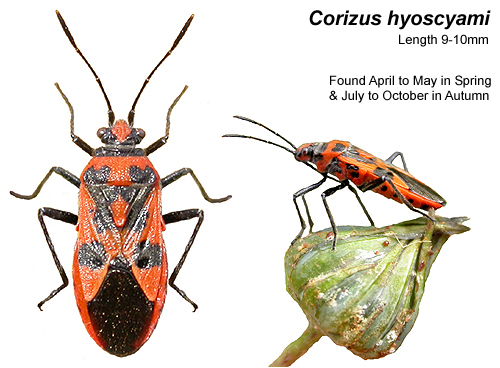 |
|
| ...... | ||
| The number of reports from the UK's south coast increased over the next decade as Corizus hyoscyami arrived from the near continent and it became a permanent resident. |
| ...... | ||
| Corizus
hyoscyami and the move north Like many others colonisers, following a period of localised spread, Corizus hyoscyami began to move north and the number of inland records away from the south coast increased. Its northwards progression, has been helped by its ease of identification and relatively large size of around 1cm, making it an easy species for the public to notice and identify. It can also turn up anywhere, with no real specific habitat requirements and is found in the weedy corners of fields, brownfield sites, woodland rides, hedgerows and gardens. Nottinghamshire records It seemed that it would only be a matter of time before Corizus hyoscyami reached Nottinghamshire and by 2012, it had been found several times in neighbouring Leicestershire. We conducted casual searches of likely sites during 2012, feeling sure that Corizus hyoscyami would soon turn up, but it wasn't until August 9th 2013, that we were emailed a photograph of a bug found by David Yates in his Southwell garden on August 8th. The bug in the photograph was Corizus hyoscyami and we congratulated David on what we thought was the first Nottinghamshire record. However, on the same day as we received the photograph from David, Tim Sexton (assitant manager at Attenborough Nature Reserve) also sent us an email following a Bioblitz event which we had attended. Tim's email told of how a member of the public had taken a specimen of Corizus hyoscyami which had been found locally, to the visitor centre at Attenborough NR for identification. It seemed quite remarkable, that Nottinghamshire suddenly had two records of a new species in as many days. But the story of Corizus hyoscyami's addition to the county's fauna, doesn't end there. After reading about the Southwell and Attenborough records of Corizus, we were contacted by Adrian Dutton, who had found and photographed two at Shelford on April 20th 2011. Adrian was unaware at the time, that his record was actually Nottinghamshire's first. |
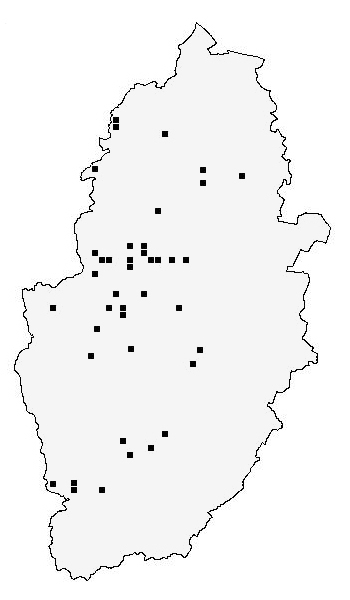 |
|
| ...... | ||
| Additional
records of Corizus hyoscyami Following on from the sending and receiving of numerous emails, we immediately started to conduct searches of what we thought might be suitable sites and soon found two Corizus hyoscyami on a brownfield site at New Ollerton on August 18th 2013. One was still present in the same location, when we revisited the site again almost a week later. |
||
| ...... | ||
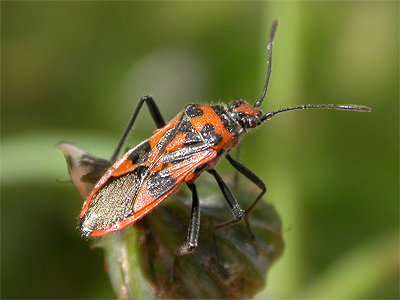 |
Another (our third record at the time) was then found in the weedy corner of recently a harvested field at King's Wood near Market Warsop on 08/09/13. To find Corizus at two different locations and within the space of a few weeks, we assumed that it was reasonably well established in Nottinghamshire by the end of 2013. There were six records between May 18th and September 7th during 2014. This included four records within quick succession from Dyscarr Wood by Pauline Bradford, which photographically proved that they related to at least two different individuals. There were also records from new sites at Nettleworth Manor near Mansfield Woodhouse and Netherfield Lagoons.2015 represented the most prosperous year yet for Corizus hyoscyami. During the year, there was another record from Attenborough NR, gardens at Carlton in Nottingham, Langold near Worksop and at from Skegby. It was also recorded at Colwick CP, Market Warsop, Rainworth Heath and twice from Netherfield. |
|
| ...... | ||
|
2016 saw records from further new sites. All were during May apart from a single September record from Netherfield Lagoons. New sites where Corizus was found included Sherwood Forest CP, Nottingham Trent University's Brackenhurst Campus near Southwell and Burstheart Hill at Sherwood Heath SSSI. Looking for Corizus hyoscyami Corizus hyoscyami pass the Winter as adults, reappearing in Spring when breeding takes place, with a new generation of adults occurring from August onwards. On the basis of the 25 Nottinghamshire records we have at our disposal, the best chance of seeing this strikingly attractive Rhopalid Bug is in May and later in the year from August to September. Identification should (presently) not be a problem, as unlike the UK's two other red and black Bugs - Arocatus longiceps (Lygaeidae) and Pyrrhocoris apterus (Pyrrhocoridae), Corizus hyoscyami shows an obvious area of bright red on the head. Both A. longiceps and P. apterus do not occur in Nottinghamshire, although A. longiceps was found new to Leicestershire in February 2016 (per NatureSpot website). |
||
| ...... | ||
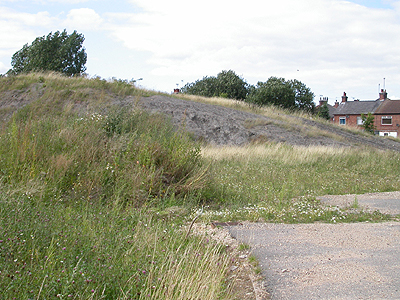 |
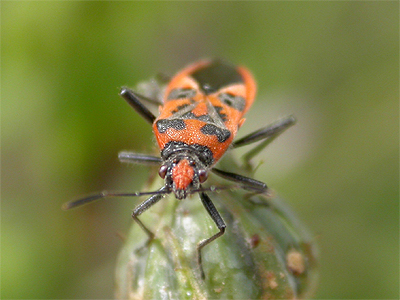 |
|
| ...... | ||
| Above left is the brownfield site at New Ollerton, where we found our first specimens in 2013. Both were found on Sow Thistle (Sonchus sp) growing on the mound shown centre left of the photograph. They favoured the sheltered side of the mound, although none were found here in Spring 2014 when we searched. In early August 2014, a casual check of a weedy field edge at Nettleworth Manor near Mansfield Woodhouse, produced another Corizus hyoscyami on Pineapple Weed (Matricaria discoidea) so any sites such as these are well worth searching. | ||
| ...... | ||
| Short summary of Corizus hyoscyami records in Nottinghamshire (VC56) | ||
| ...... | ||
| By the end of 2022, there has been a total of approximately 56 Nottinghamshire (VC56) records. But there are known to be multiple records now for some Trent Valley sites such as Netherfield Ash Lagoons, which have been included in the following yearly summaries where known and which appear to be becoming more common at many sites. | ||
| 2011 | The first documented Nottinghamshire record of two Corizus hyoscyami, found by Adrian Dutton at Shelford on April 20th | |
| 2012 | No records | |
| 2013 | Five records between August 10th and September 8th | |
| 2014 | Seven records occurring between May 18th and September 7th | |
| 2015 | A total of 11 records occurring between May 10-13th and August 15th to October 1st | |
| 2016 | Six records between May 12th and 28th, with just a single Autumn record on September 11th. | |
| 2017 | Just a single record on August 29th. | |
| 2018 | Records from Brackenhurst on July 23rd, Wellow Park on July 27th and two at Clipstone Old Quarter on August 30th. | |
| 2019 | An unusually early record of one from Wellow Park on February 22nd and records from Toton (Barry Lygo) and Clipstone Old Quarter. | |
| 2020 | JuA total of nine records from six different sites, including Treswell Wood (Josh Hedley) Thoresby Pit Top, Wellow Park and Sherwood Forest CP. | |
| 2021 | 11 records from nine sites and presumably now much under-recorded in the county. | |